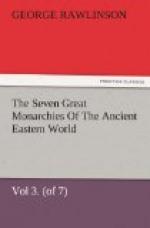and death from cold is uncommon. The spring sets
in about the beginning of March, and is at first somewhat
cool, owing to the prevalence of the
baude caucasan
or north wind,a which blows from districts where the
snow still lies. But after a little time the weather
becomes delicious; the orchards are a mass of blossom;
the rose gardens come into bloom; the cultivated lands
are covered with springing crops; the desert itself
wears a light livery of green. Every sense is
gratified; the nightingale bursts out with a full
gush of song; the air plays softly upon the cheek,
and comes loaded with fragrance. Too soon, however,
this charming time passes away, and the summer heats
begin, in some places as early as June 18 The thermometer
at midday rises to 90 or 100 degrees. Hot gusts
blow from the desert, sometimes with great violence.
The atmosphere is described as choking; and in parts
of the plateau it is usual for the inhabitants to
quit their towns almost in a body, and retire for several
months into the mountains. This extreme heat is,
however, exceptional; in most parts of the plateau
the summer warmth is tempered by cool breezes from
the surrounding mountains, on which there is always
a good deal of snow. At Hamadan, which, though
on the plain, is close to the mountains, the thermometer
seems scarcely ever to rise above 90 deg., and that
degree of heat is attained only for a few hours in
the day. The mornings and evenings are cool and
refreshing; and altogether the climate quite justifies
the choice of the Persian monarchs, who selected Ecbatana
for their place of residence during the hottest portion
of the year. Even at Isfahan, which is on the
edge of the desert, the heat is neither extreme nor
prolonged. The hot gusts which blow from the east
and from the south raise the temperature at times nearly
to a hundred degrees; but these oppressive winds alternate
with cooler breezes from the west, often accompanied
by rain; and the average highest temperature during
the day in the hottest month, which is August, does
not exceed 90 deg..
A peculiarity in the climate of the plateau which
deserves to be noticed is the extreme dryness of the
atmosphere. In summer the rains which fall are
slight, and they are soon absorbed by the thirsty soil.
There is a little dew at nights, especially in the
vicinity of the few streams; but it disappears with
the first hour of sunshine, and the air is left without
a particle of moisture. In winter the dryness
is equally great; frost taking the place of heat,
with the same effect upon the atmosphere. Unhealthy
exhalations are thus avoided, and the salubrity of
the climate is increased; but the European will sometimes
sigh for the soft, balmy airs of his own land, which
have come flying over the sea, and seem to bring their
wings still dank with the ocean spray.




